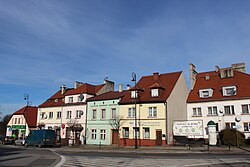| Sośnicowice Kieferstädtel | |
|---|---|
 Central square Central square | |
 Flag Flag Coat of arms Coat of arms | |
 Kieferstädtel | |
| Coordinates: 50°17′0″N 18°32′0″E / 50.28333°N 18.53333°E / 50.28333; 18.53333 | |
| Country | |
| Voivodeship | Silesian |
| County | Gliwice |
| Gmina | Sośnicowice |
| First mentioned | 1305 |
| Government | |
| • Mayor | Leszek Kołodziej |
| Area | |
| • Total | 11.68 km (4.51 sq mi) |
| Elevation | 250 m (820 ft) |
| Population | |
| • Total | 1,919 |
| • Density | 160/km (430/sq mi) |
| Time zone | UTC+1 (CET) |
| • Summer (DST) | UTC+2 (CEST) |
| Postal code | 44-153 |
| Car plates | SGL |
| Climate | Cfb |
| Primary airport | Katowice Airport |
| Highways | |
| Voivodeship roads | |
| Website | http://www.sosnicowice.pl/ |
Sośnicowice (Polish: [sɔɕɲit͡sɔˈvit͡sɛ]) or Kieferstädtel (German: [ˈkiːfɛɐ̯ʃtɛtəl]) is a town in Gliwice County, Silesian Voivodeship, Poland, with 1,919 inhabitants (2019). It is the capital of Gmina Sośnicowice, which has been officially bilingual in Polish and German since 2013.
Geography
Sośnicowice is located in Upper Silesia on the Kłodnica and Bierawka rivers on the western edge of the Upper Silesian Industrial Region, about 8 km southwest of the center of Gliwice.
History
The town was first mentioned in 1305 when it was part of the Duchy of Opole within fragmented Piast-ruled Poland. The name of the town is of Polish origin and comes from the word sosna which means "pine".
It eventually fell under suzerainty of the Bohemian Crown (within the Habsburg monarchy since 1526), however, it remained ruled by the Opole line of the Polish Piast dynasty until 1532. In 1526, it was granted town rights by Ferdinand I, for which the forest had been cleared by residents who immigrated from Bohemia. At first, Czech immigrants spoke Czech, but gradually the Czech language was replaced by Polish again. The town passed into the possession of various noble families. Soon afterwards, the Reformation took hold in the town, after which the parish church was taken over by the Protestants in 1555, in whose hands it remained until 1679. With the Counter-Reformation of the Habsburgs, the city was re-Catholicized. The town was devastated by Swedish troops during the Thirty Years' War in 1626.
The town became part of the Kingdom of Prussia in 1742, after the First Silesian War. During the Seven Years' War from 1756 to 1763, it was burned to the ground. The town was subjected to Germanisation policies, and in the 1860s, Polish was still dominant in the town, however, already about a third of the inhabitants spoke German. In January 1871, the town, known in German as Kieferstädtel became part of the German Empire and was located in the Tost-Gleiwitz district in the Prussian Province of Silesia. In the 1921 Upper Silesia plebiscite, 78.3% of the residents of Kieferstädtel voted to remain in Germany. During the Kristallnacht in 1938, the wooden buildings on the small Jewish cemetery southeast of Kieferstädtel were burned down. At that time, however, there were no longer any Jews living in the town.
Towards the end of World War II, the town was captured by the Red Army on January 27, 1945. After the end of the war, the town became again part of Poland under the terms of the Potsdam Agreement.
Demographics
|
| |||||||||||||||||||||||||||
| Source: | ||||||||||||||||||||||||||||
Sights
Landmarks of Sośnicowice include the Baroque Sośnicowice Palace and Saint James church.
-
 Saint James church
Saint James church
-
 Sośnicowice Palace
Sośnicowice Palace
-
 Monument to the insurgents of the Silesian Uprisings
Monument to the insurgents of the Silesian Uprisings
Twin towns – sister cities
See twin towns of Gmina Sośnicowice.
References
- "Population. Size and structure and vital statistics in Poland by territorial division in 2019. As of 30th June". stat.gov.pl. Statistics Poland. 2019-10-15. Retrieved 2020-03-13.
- "Deutsche Minderheit in Polen - Zweisprachige Ortsschilder in Kieferstädtel!". 2016-12-28. Archived from the original on 2016-12-28. Retrieved 2021-04-15.
- Damrot, Konstanty (1896). Die älteren Ortsnamen Schlesiens, ihre Entstehung und Bedeutung. Mit einem Anhange über die schlesisch-polnischen Personennamen. Beiträge zur schlesischen Geschichte und Volkskunde (in German). Verlag von Felix Kasprzyk. p. 178.
- ^ Triest, Felix (1864). Topographisches Handbuch von Oberschlesien. Erste Hälfte (in German). p. 537.
- Słownik geograficzny Królestwa Polskiego i innych krajów słowiańskich, Tom XI (in Polish). Warszawa. 1890. p. 89.
{{cite book}}: CS1 maint: location missing publisher (link) - "Landsmannschaft der Oberschlesier in Karlsruhe". 2016-03-04. Archived from the original on 2016-03-04. Retrieved 2021-07-20.
- Dokumentacja Geograficzna (in Polish). Vol. 3/4. Warszawa: Instytut Geografii Polskiej Akademii Nauk. 1967. p. 47.
- Stan i struktura ludności oraz ruch naturalny w przekroju terytorialnym w 2010 r. (PDF) (in Polish). Warszawa: Główny Urząd Statystyczny. 2011. p. 93. Archived from the original (PDF) on 13 November 2011.
External links
- Official website at Sosnicowice.pl
- Jewish Community in Sośnicowice on Virtual Shtetl
![]() Media related to Sośnicowice at Wikimedia Commons
Media related to Sośnicowice at Wikimedia Commons
| Gmina Sośnicowice | ||
|---|---|---|
| Town and seat |  | |
| Villages | ||